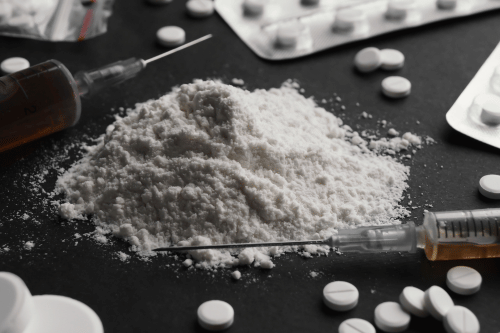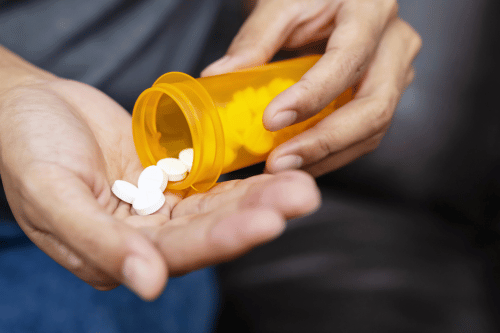

The transition from Adderall to meth highlights a concerning pattern in substance abuse, where people shift from prescribed medications to illegal street drugs. While Adderall is a prescription medication used to treat ADHD (Attention Deficit Hyperactivity Disorder), methamphetamine, often referred to as crystal meth, is a highly addictive illicit street drug associated with devastating health effects. ADHD treatment often involves medications like Adderall and methamphetamine, which have similar effects but vastly different safety profiles. Understanding the similarities between these drugs and the risks associated with misuse is essential to prevent addiction and protect mental health.

Adderall is a prescription stimulant that contains amphetamine salts, designed to improve focus and control impulsive behaviors in people diagnosed with ADHD. This Schedule II controlled substance is also prescribed for conditions like narcolepsy. Under doctor’s supervision, it can be effective for individuals struggling with ADHD. However, taking Adderall without proper medical oversight or exceeding prescribed doses increases the risk of stimulant addiction.
Stimulant medications like Adderall and Desoxyn are legal when prescribed and monitored by a healthcare professional. They work by increasing dopamine and norepinephrine levels in the brain, enhancing alertness and concentration. While these medications provide benefits, misuse of Adderall as a recreational drug can lead to dependency, with users chasing its stimulating effects. It is important to distinguish these legal stimulant medications from illegal drugs like methamphetamine, which carry significant risks and are not subject to medical supervision.
Prescription drug abuse is a growing concern in the United States, with millions of people misusing prescription medications every year. The risks associated with this abuse are numerous and can have serious consequences, including addiction, overdose, and even death.
One of the most commonly abused prescription medications is Adderall, a stimulant medication used to treat Attention Deficit Hyperactivity Disorder (ADHD). While Adderall can be an effective treatment for ADHD, it can also be highly addictive, especially when taken in large doses or for extended periods. Misusing Adderall can lead to a range of health issues, including heart problems, anxiety, and severe insomnia.
Another significant risk of prescription drug abuse is the potential for users to transition to illicit substances. For example, individuals who abuse Adderall may eventually turn to crystal meth, a highly addictive and potent stimulant that can have devastating consequences. Crystal meth is often produced in illegal labs and can contain dangerous ingredients, making it even more hazardous than prescription stimulants.
Understanding the risks of prescription drug abuse is crucial for preventing addiction and protecting mental and physical health. By raising awareness and promoting responsible use of medications, we can help reduce the prevalence of substance use disorders.
Methamphetamine, also known as crystal meth, is a powerful stimulant drug classified as a Schedule II controlled substance when used in limited medical contexts. However, most meth on the streets is illegally produced and distributed, making it an illicit drug. Unlike Adderall, which is a regulated prescription drug, meth is typically consumed for its euphoric high, leading to severe substance use disorders. Prolonged use of meth is linked to numerous physical and psychological issues, including meth mouth, hallucinations, weight loss, and paranoia.
Meth’s high potency stems from an added methyl group, allowing it to penetrate the blood-brain barrier more effectively. This chemical similarity to Adderall explains why some individuals transition from prescription methamphetamine or Adderall to illicit meth, seeking stronger effects.

Both Adderall and meth fall under the category of amphetamine drugs, sharing overlapping chemical structures and stimulating the central nervous system. Both substances increase dopamine levels, but meth acts faster and with more intensity, causing profound behavioral changes. While Adderall and methamphetamine share some therapeutic properties, such as treating ADHD, meth’s unregulated nature makes it far more dangerous.
Meth’s ability to deliver stronger euphoric effects contributes to its addictive potential. This similarity makes people who abuse Adderall more vulnerable to trying meth. The shift from meth and Adderall misuse is particularly dangerous because meth users tend to experience significant cognitive and physical decline over time.
People abusing Adderall often develop a tolerance, needing higher doses to achieve the same results. In some cases, when prescription refills run out or Adderall becomes unavailable, individuals may seek out methamphetamine to replicate the desired effects. Since both Adderall and meth stimulate the brain similarly, users falsely believe that meth offers a comparable solution.
Additionally, some individuals misuse stimulants like Adderall to lose weight, enhance performance, or combat fatigue. When meth is introduced, its stronger effects create a quick dependency, making it hard to stop without professional intervention. This transition exemplifies the dangers of prescription stimulant misuse.
The pathway from prescription medication to illicit substances is a common one, often beginning with the misuse of prescription stimulants like Adderall. When individuals take Adderall for non-medical reasons or in large doses, they can develop a tolerance to the medication, leading them to seek out stronger stimulants like crystal meth.
Crystal meth is a highly addictive and potent stimulant that can have devastating consequences, including addiction, overdose, and even death. It is often produced in illegal labs and can contain a range of dangerous ingredients, including toxic chemicals and other substances. The transition from prescription medication to illicit substances can be facilitated by various factors, including peer pressure, easy access to illicit substances, and a lack of education about the risks of prescription drug abuse.
This dangerous pathway underscores the importance of using prescription medications responsibly and under the guidance of a healthcare professional. By understanding the risks and taking preventive measures, individuals can avoid the slippery slope from prescription drug misuse to illicit substance abuse.
Stimulant addiction can have devastating effects on an individual’s mental health. Over time, both Adderall and meth abuse can lead to increased anxiety, paranoia, and depression. These stimulant drugs, often prescribed for ADHD treatment, play a crucial role in stabilizing thought patterns and enhancing focus. However, their misuse disrupts natural dopamine production, leaving users unable to feel pleasure without the drug. Given their classification as Schedule II drugs, responsible use is paramount to avoid addiction. Many people who misuse these substances also struggle with co-occurring mental health disorders, complicating the recovery process.
At Sullivan Recovery, treatment programs focus on addressing the complex interplay between stimulant addiction and mental health disorders. Through evidence-based therapies and medical detox, individuals can safely overcome dependency and rebuild their lives.
Stimulant addiction can be difficult to recognize, but there are several signs that may indicate a problem. These include:
Taking larger doses of the medication than prescribed
Taking the medication more frequently than prescribed
Using the medication for non-medical reasons, such as to stay awake or to enhance performance
Experiencing withdrawal symptoms when the medication is stopped
Continuing to use the medication despite negative consequences, such as relationship problems or financial difficulties
Feeling a strong urge or craving to use the medication
Spending a lot of time thinking about the medication or trying to obtain it
If you or someone you know is experiencing any of these signs, it may be a sign of stimulant addiction. It’s important to seek help from a healthcare professional or addiction treatment center as soon as possible.
In addition to these signs, several other factors can increase the risk of stimulant addiction, including:
A history of substance abuse or addiction
A family history of substance abuse or addiction
Mental health conditions, such as depression or anxiety
Trauma or stress
Easy access to illicit substances
By recognizing the signs of stimulant addiction and understanding the risks of prescription drug abuse, individuals can take steps to protect themselves and their loved ones from the dangers of addiction. Early intervention and professional treatment are crucial for overcoming stimulant addiction and achieving long-term recovery.
Aspect | Adderall | Methamphetamine |
|---|---|---|
Legal Status | Prescription drug (Schedule II) | Illegal in most cases (Schedule II) |
Medical Use | ADHD, narcolepsy | Limited medical use |
Administration | Oral pills | Smoked, snorted, injected |
Onset of Effects | Gradual | Rapid |
Risk of Dependency | Moderate | High |
Associated Health Issues | Insomnia, anxiety, weight loss | Paranoia, hallucinations, meth mouth |
Both drugs carry risks of abuse, but meth’s potency makes it significantly more dangerous. The transition from Adderall to methamphetamine typically results in quicker deterioration of both physical and mental health.
Switching between stimulants, or using them simultaneously, poses severe risks. Individuals who mix Adderall with other stimulants—whether intentional or not—can suffer from heart problems, increased blood pressure, and severe anxiety. Both substances are highly addictive stimulants, and attempting to replace one with the other leads to dangerous outcomes, including memory loss and psychosis.
Recovering from stimulant addiction requires professional intervention, especially for individuals who have shifted from Adderall to meth. At Sullivan Recovery, personalized treatment plans include medical detox to manage withdrawal symptoms, therapy to address underlying mental health issues, and support groups to foster long-term sobriety.
It is crucial to involve a medical doctor and other healthcare professionals in the recovery process, ensuring that patients receive comprehensive care. Alternative ADHD treatments may be explored to prevent relapse and support a healthier lifestyle without the reliance on stimulants.
The transition from Adderall to methamphetamine highlights the fine line between legal prescription stimulants and dangerous street drugs. Although Adderall is a prescription medication that serves an important role in treating ADHD, misuse can have dangerous consequences. Methamphetamine offers similar effects but with far more devastating outcomes, posing severe risks to both the brain and body.
Raising awareness about the risks of stimulant misuse is essential. Individuals struggling with substance use disorders must understand the importance of seeking help early. Sullivan Recovery offers compassionate care, helping patients break free from stimulant addiction and rebuild their lives.

At Sullivan Recovery, as an in-network provider we work with most insurance plans, such as:
And More
If you or a loved one are struggling with mental health challenges or substance abuse, reach out to Sullivan Recovery today. Our team of compassionate professionals is here to support your journey towards lasting well-being. Give us a call at 949-836-7180.
When someone transitions from Adderall to meth, they experience more intense euphoric effects due to meth’s higher potency. However, meth is far more dangerous, leading to rapid addiction, severe physical deterioration, mental health issues like paranoia, and conditions such as meth mouth. Long-term meth use can cause significant cognitive decline and increase the risk of psychosis.
People misuse Adderall for various reasons, including improving focus, staying awake, enhancing performance, and even achieving weight loss. When misused, the drug can lead to dependency and addiction, making individuals more prone to seeking stronger stimulants like meth if tolerance develops or access to the prescription becomes limited.
Adderall and methamphetamine are both amphetamine drugs with overlapping chemical structures. Meth contains an added methyl group, which allows it to cross the blood-brain barrier more efficiently, delivering more intense and faster effects on the central nervous system. Despite these similarities, meth’s unregulated and illicit use makes it far more dangerous.
Treatment for stimulant addiction typically involves medical detox, behavioral therapies, and medication-assisted treatment. At Sullivan Recovery, patients receive individualized care, including mental health support and therapy to address co-occurring disorders. Alternative ADHD treatments may also be explored to prevent relapse and ensure sustained recovery.